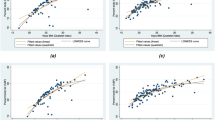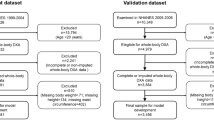Abstract
Although body mass index (BMI) and body fat percentage (B F %) are well known as indicators of nutritional status, there are insuficient data whether the relationship between them is linear or not. There are appropriate linear and quadratic formulas that are available to predict B F % from age, gender and BMI. On the other hand, our previous research has shown that artificial neural network (ANN) is a more accurate method for that. The aim of this study is to analyze relationship between BMI and B F % by using ANN and big dataset (3058 persons). Our results show that this relationship is rather quadratic than linear for both gender and all age groups. Comparing genders, quadratic relathionship is more pronounced in women, while linear relationship is more pronounced in men. Additionaly, our results show that quadratic relationship is more pronounced in old than in young and middle-age men and it is slightly more pronounced in young and middle-age than in old women.





Similar content being viewed by others
References
World Health Organization, Obesity: preventing and managing the global epidemic. Report of a WHO consultation. World Health Organ. Tech. Rep. Ser. 894:1–253, 2000.
Kuk, J. L., Lee, S., Heymsfield, S. B., and Ross, R., Waist circumference and abdominal adipose tissue distribution: influence of age and sex. Am. J. Clin. Nutr. 81:1330–1334, 2005.
Cartwright, M. J., Tchkonia, T., and Kirkland, J. L., Aging of adipocytes: potential impact of inherent, depot-specific mechanisms. Exp. Gerontol. 42:463–471, 2007.
Gallagher, D., Visser, M., Sepulveda, D., Pierson, R., Harris, T., and Heymsfield, S. B., How Useful is Body Mass Index for Comparison of Body Fatness across Age, Sex and Ethnic Groups? Am. J. Epidemiol. 143(3): 228–239, 1996.
Jackson, A. S., Stanforth, P. R., Gagnon, J., Rankinen, T., Leon, A. S., Rao, D. C., Skinner, J. S., Bouchard, C., and Wilmore, J. H., The effect of sex, age and race on estimating percentage body fat from body mass index: The Heritage Family Study. Int. J. Obes. 26:789–796, 2002.
Forbes, G. B., Human body composition. New York: Springer Verlag, 1987.
Meeuwsen, S., Horgan, G. W., and Elia, M., The relationship between BMI and percent body fat, measured by bioelectrical impedance, in a large adult sample is curvilinear and influenced by age and sex. Clin. Nutr. 29:560–566, 2010.
Robergs, R. A., and Roberts S. O., Exercise physiology, Performance, and clinical Applications helah and disease. 2nd edn, pp. 61–82, 1997. Philadelphia.
Blaak, E., Gender differences in fat metabolism. Curr. Opin. Clin. Nutr. Metab. Care 4(6):499–502, 2001.
Lwin, R., Darnell, B., Oster, R., Lawrence, J., Foster, J., Azziz, R., and Gower, B. A., Effect of oral estrogen on substrate utilization in postmenopausal women. Fertil. Steril. 90(4):1275–1278, 2008.
Ranasinghe, C., Gamage1, P., Katulanda, P., Andraweera1, N., Thilakarathne, S., and Tharanga, P., Relationship between Body mass index (BMI) and body fat percentage, estimated by bioelectrical impedance, in a group of Sri Lankan adults: a cross sectional study. BMC Public Health 13:797, 2013. doi:10.1186/1471-2458-13-797.
Deurenberg, P., Weststrate, J. A., and Seidell, J. C., Body mass index as a measure of body fatness: age- and sex- specific prediction formulas. Br. J. Nutr. 65:105–114, 1991.
Deurenberg, P., Yap, M., and van Staveren W. A., Body mass index and percent body fat, a meta analysis among different ethnic groups. Int. J. Obes. Relat. Metab. Disord. 22:1164–1171, 1998.
Jackson, A. S., Research design and analysis of data procedures for predicting body density. Med. Sci. Sports Exerc. 16(6):616–620, 1984.
Jackson, A. S., Pollock, M. L., and Ward, A., Generalized equations for predicting body density of women. Med. Sci. Sports. Exerc. 12(3):175–182, 1980.
Sun, S. S., Chumlea, W. C., Heymsfield, S. B., Lukaski, H. C., Schoeller, D., Friedl, K., Kuczmarski, R. J., Flegal, K. M., Johnson, C. L., and Hubbard, V. S., Development of bioelectrical impedance analysis prediction equations for body composition with the use of a multicomponent model for use in epidemiologic surveys. Am. J. Clin. Nutr. 77(2):331–340, 2003.
Kupusinac, A., Doroslovački R., Malbaški D., Srdić B., and Stokić E., A primary estimation of the cardiometabolic risk by using artificial neural networks. Comput. Biol. Med. 43(6):751–757, 2013.
Abdul-Kareem, S., Baba, S., Zubairi, Y. Z., and Wahid, M. I. A., As a tool for medical prognosis. Health Inform. J. 6(3):162–165, 2000.
Sheikhtaheri, A., Sadoughi, F., and Dehaghi, Z. H., Developing and Using Expert Systems and Neural Networks in Medicine: A Review on Benefits and Challenges. J. Med. Syst. 3(9):8:110, 2014.
Kupusinac, A., Stokić, E., and Doroslovački R., Predicting body fat percentage based on gender, age and BMI by using artificial neural networks. Comput. Methods Programs Biomed. 113(2):610–619, 2014.
Antuna-Puente, B., Feve, B., Fellahi, S., and Bastard, P., Adipokines: The missing link between insulin resistence and obesity. Diabetes Metab. 34(1):2–11, 2008.
Blum, W. F., Englaro, P., Hanitsch, S., Juul, A., Hertel, N. T., Mller, J., Skakkebaek, N. E., Heiman, M. L., Birkett, M., Attanasio, A. M., Kiess, W., and Rascher, W., Plasma leptin level in healthy children and adolescents: Dependence ojn body mass index, body fat mass, gender, pubertal stage nad testosteron. J. Clin. Endocrinol. Metab. 82(9):2904–2910, 1997.
Considine, R. V., Sinha, M. K., Heiman, M. L., Kriauciunas, A., Stephens, T. W., Nyce, M. R., Ohannesian, J. P., Marco, C. C., McKee, L. J., Bauer, T. L., and et al., Serum immunoreactive leptin concentations in normal weight and obese humans. N. Engl. J. Med. 334(5):292–295, 1996.
Elminger, M. W., Kuhnel, W., and Ranke, M. B., Reference ranges for serum concentrations of lutropin(LH), follitropin(FSH), estradiol(E2), Prolactin, progesterone, sex hormone-binding globulin (SHBG), dehydroepiandrosterone sulfate(DHEAS), cortisol and ferritin in neonates, children and young adults. Clin. Chem. Lab. Med. 40(11):1151–1160, 2002.
Caprio, S., Daniels, S. R., Drewnowski, A., Kaufman, F. R., Palinkas, L. A., Rosenbloom, A. L., and Schwimmer, J. B., Influence of Race, Ethnicity, and Culture on Childhood Obesity: Implications for Prevention and Treatment: A consensus statement of Shaping Americas Health and the Obesity Society. Diabetes Care 31(11): 2211–2221, 2008. doi:10.2337/dc08-9024.
Acknowledgments
This work was partially supported by the Ministry of Education, Science and Technological Development of the Republic of Serbia within the projects: ON 174026 and III 044006, and by the Provincial Secretariat for Higher Education and Scientific Research of the Autonomous Province of Vojvodina within the project: 114-451-2856/2016-03.
Author information
Authors and Affiliations
Corresponding author
Additional information
This article is part of the Topical Collection on Advances in Big-Data based mHealth Theories and Applications
Rights and permissions
About this article
Cite this article
Kupusinac, A., Stokić, E., Sukić, E. et al. What kind of Relationship is Between Body Mass Index and Body Fat Percentage?. J Med Syst 41, 5 (2017). https://doi.org/10.1007/s10916-016-0636-9
Received:
Accepted:
Published:
DOI: https://doi.org/10.1007/s10916-016-0636-9




